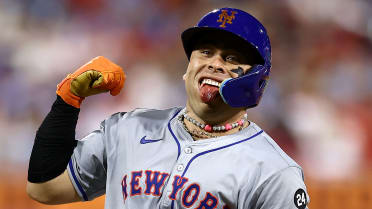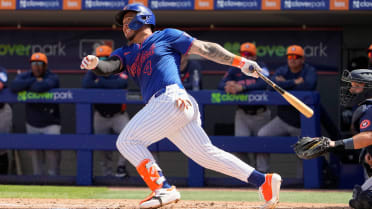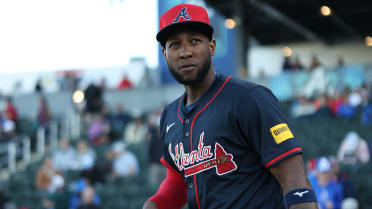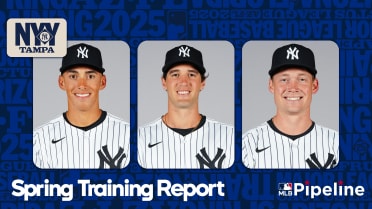Astros set roster for ALDS vs. White Sox
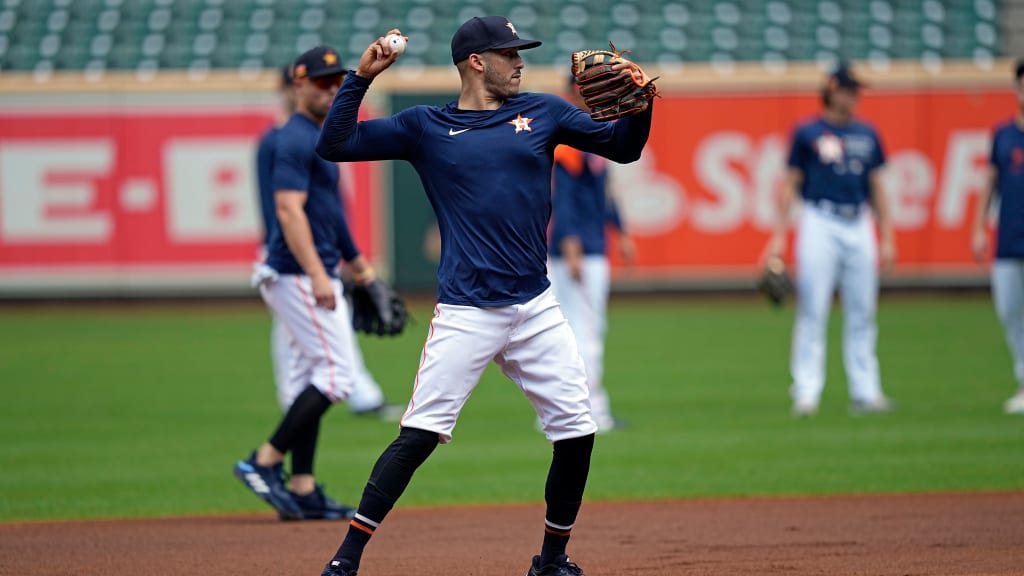
HOUSTON -- The Astros on Thursday set their 26-man roster for the American League Division Series, which didn’t include starting pitcher Jake Odorizzi, who was signed to a two-year deal in March. Veteran infielder Marwin Gonzalez, signed in August, also didn’t make the roster.
The Astros chose to carry 12 pitchers, three catchers and six outfielders, with Jose Siri making his first playoff roster, primarily as a pinch-running option. Garrett Stubbs will be the third catcher, allowing the Astros to be aggressive in pinch-hitting for Martín Maldonado late in games.
In addition to Siri, pitcher Kendall Graveman and outfielders Chas McCormick and Jake Meyers are seeking their first playoff experience.
Martín Maldonado, starting catcher: Maldonado had a bad year on offense in the No. 9 hole, but a combination of veteran leadership, defense and his throwing arm keeps him in the lineup. He has caught the second-most innings in the Major Leagues this year and ranks third in caught stealing percentage (39.6). Offensively, his .573 OPS and 58 OPS+ are among the worst in MLB. But the Astros were 72-46 when Maldonado started, 19-18 when Jason Castro started and 4-3 when Garrett Stubbs started.
Jason Castro, backup catcher: Castro re-signed this year with the club he broke into the Major Leagues with to serve as Maldonado’s backup, and he may start once in a series, if at all. This season, he started 38 games, and he generally brings a bit more offense than Maldonado. Castro draws walks, has some pop (eight homers in 149 at-bats) and had a .799 OPS. There’s a falloff defensively, though, because Castro has thrown out only 13 percent of attempted steals (4-of-31).
Garrett Stubbs, third catcher: Carrying a third catcher provides the Astros with flexibility with pinch-hitting for Maldonado and Castro, in addition to having a backup option should one of the other two get injured. Stubbs can also run well, so he could be a pinch-running option. He doesn’t bring much to the table offensively, with a .485 career OPS and no homers in 51 career games.
Yuli Gurriel, starting first baseman: One of the best defensive first basemen in the game, Gurriel, 37, has enjoyed a bounceback year at the plate, and he became the second Astros player to win a batting title by leading the AL with a .319 average. Defensively, he has blossomed into one of the steadiest hands at first base, and he has saved numerous errors by his infielders by scooping out low throws with ease.
Jose Altuve, starting second baseman: Altuve, who was named to his seventh All-Star team this year, isn’t the offensive player he once was, but he tied a career high in homers (31) this season while taking over for George Springer in the leadoff spot. He’s one of the most experienced postseason players in the game and is tied for sixth all time with 18 playoff homers, including his pennant-clinching walk-off against the Yankees in 2019. Altuve has also displayed no troubles throwing the ball to first base, which was an issue for him a year ago.
Carlos Correa, starting shortstop: If the name “Mr. October” weren't already taken, it could apply to Correa, who’s one of the most clutch playoff performers in history. He’s tied for ninth all time with 17 career postseason homers across five seasons. Correa, a free agent at the end of the year, had one of his best years offensively in 2021, hitting a career-high 26 homers while managing to remain healthy and in the lineup. He also continues to play at an elite level at shortstop and is unquestionably the Astros’ leader on and off the field. And he’s only 27 years old.
Alex Bregman, starting third baseman: Bregman missed 59 games in the middle of the season while overcoming a strained quad, but he has been a productive and dangerous player when healthy. He has hit 11 career postseason homers off some of the biggest names in the game, including Chris Sale, Clayton Kershaw, Kenley Jansen, Corey Kluber, Trevor Bauer, Blake Snell, Chris Bassitt and two off Stephen Strasburg in the 2019 World Series. Bregman revels in big moments and big situations and always plays with a chip on his shoulder.
Michael Brantley, starting left fielder: Brantley’s balky knee could be a concern entering the playoffs. Will it be healthy enough to allow him to play left field, or will he be limited to a designated hitter role? That could force the Astros to play DH Yordan Alvarez in left field more, which isn’t ideal. Brantley remains an elite hitter (he tied with Toronto’s Vladimir Guerrero Jr. for second in the AL in batting average this year at .311), but he doesn’t hit for much power anymore. Still, he’s a bat the Astros sorely need in the order.
Jake Meyers, starting center fielder: Called up at the Trade Deadline after the Astros dealt Myles Straw to Cleveland, Meyers was slated to be the club’s fourth outfielder, with Chas McCormick taking over as the starter in center. When Kyle Tucker went on the COVID-19 IL, McCormick started in right and Meyers took over in center and played well. Either he or McCormick will be starting in center.
Kyle Tucker, starting right fielder: Tucker has emerged as a force in the middle of the Astros’ lineup and has had a career year, shaking off a slow start (he hit .188 with a .651 OPS in his first 34 games of the season). Tucker finished third in the AL in OPS behind Guerrero and Shohei Ohtani at .917, hit a career-high 30 homers and was named the AL Player of the Month for September. He has been a surprisingly solid fielder, too, leading AL right fielders in fielding percentage (.992) and zone rating (.950).
Yordan Alvarez, designated hitter: After being limited to two games in last year's abbreviated season following surgery on both knees in August, Alvarez had the kind of year the Astros had hoped following his incredible 2019 AL Rookie of the Year Award season. He led the team in homers (33) and RBIs (104) and proved to be a proficient left fielder, where he played quite a bit after being limited to DH duties to start his career. Alvarez hits cleanup in one of the most dangerous lineups in baseball.
Aledmys Díaz, utility infielder: Díaz will be the Astros’ first position player off the bench and first pinch-hit option, though he could get a start in one of the games. He can play left field and all four infield positions, so he will be a valuable asset for Dusty Baker and his coaching staff in the postseason. Expect him to pinch-hit if the Astros decide to hit for Maldonado at some point. Díaz missed 41 games because of a broken left hand suffered in June, but he slashed .337/.368/.525 with four homers and 19 RBIs in his first 24 games after returning in late July.
Jose Siri, backup outfielder: Siri is an enigma. He has tremendous power and can run fast, but he plays out of control at times and has a lot of swings and misses. He’s the kind of player who could make an incredible play, only to make a bigger mistake later. The Astros have been getting inconsistent production from center fielders McCormick and Meyers down the stretch, which may have opened a spot for Siri, but he’s probably limited to pinch-running at this point.
Chas McCormick, backup outfielder: McCormick and Meyers figure to split time in center at this point. Both play strong defense and have a lot of swing-and-miss in their game, but Meyers slumped down the stretch after a strong August. McCormick doesn’t get cheated on swings and has raw power. If he’s not starting, he’s likely one of the first players off the bench. He could serve as a pinch-runner or defensive replacement for Brantley in left field late in games.
Lance McCullers Jr., starting pitcher: McCullers, who finished second in the AL in ERA (3.16) and first in opponents’ batting average (.205), will start Game 1 for the Astros, putting him in line to start Game 5 should the series last that long. A ground-ball machine, McCullers went 13-5 with a 1.22 WHIP and 185 strikeouts in 162 1/3 innings, though he led the AL in walks (76). If he can get his command under control, McCullers has a chance to be dominant and pitch deep into games.
Framber Valdez, starting pitcher: Valdez, a lefty, was better against right-handers (.626 opposing OPS) this season than against left-handers (.717) thanks to one of the best curveballs in the league. That’s crucial against the White Sox and their right-handed-heavy lineup. Like McCullers, Valdez’s key will be controlling his walks. He averaged 3.88 walks per nine innings. Sidelined for the first two months of the season because of a broken left ring finger suffered in Spring Training, he went 11-6 with a 3.14 ERA in 134 2/3 innings, allowing 110 hits (12 homers) and 58 walks with 125 strikeouts.
José Urquidy, starting pitcher: Urquidy, who burst onto the scene in Game 4 of the 2019 World Series with five scoreless innings on the road against the Nationals, will likely start the third or fourth game for the Astros. He pitched around a pair of shoulder injuries – one of which kept him out in July and August -- and posted a 3.62 ERA and a 0.99 WHIP in 107 innings. Urquidy is a strike-thrower who could be a candidate to be piggybacked by Zack Greinke, because he hasn’t thrown more than 91 pitches in a start since June.
Luis Garcia, starting pitcher: Garcia, who’ll likely get some AL Rookie of the Year Award votes, is another candidate to split a game with Greinke. Garcia blew past his previous career high by throwing 155 1/3 innings, striking out 167, and he pitched more than five innings only five times in his final 12 starts. Garcia averaged only 82.4 pitches in his final five starts of the year as the Astros pulled back on his innings load.
Zack Greinke, long relief: Unless the Astros have a last-minute change of heart, Greinke will be in the bullpen, where he would be available in long relief and perhaps follow a starter. He missed time in September with a positive COVID-19 test and another IL stint with neck soreness, which hampered his ability to build up his strength before the end of the season. He made his first relief appearance since 2007 in the regular-season finale on Oct. 3 and allowed two runs in 2 1/3 innings.
Ryan Pressly, closer: One of the best closers in baseball, Pressly didn’t put up gaudy save numbers because the Astros blew so many teams out and weren’t great in close games. Pressly hasn’t pitched more than one inning a game since early in the season, as the Astros prefer him to be a one-inning closer. He averaged 11.4 strikeouts per nine innings and posted a 0.97 WHIP while converting 26 of 28 saves.
Kendall Graveman, setup: Graveman was acquired in a July trade with the Mariners to be the Astros’ eighth-inning setup man, helping them bridge the gap to Pressly more efficiently. Graveman posted a 0.82 ERA and 0.70 WHIP in 33 innings with Seattle but a 3.13 ERA and 1.39 WHIP with Houston, with his walk numbers going up. Right-handers couldn’t touch him this year (.348 OPS), but left-handers had more success against him (.748 OPS). He figures to be a good matchup against the White Sox, given their right-handed-heavy lineup.
Ryne Stanek, setup: Stanek was the Astros’ primary eighth-inning setup man before they acquired Graveman, pushing Stanek to the seventh inning in Baker’s ideal bullpen alignment with a lead. Like Graveman, lefties have hit him much harder (.817 OPS) than right-handers (.482), meaning he would be a weapon in the ALDS. Stanek can get himself in trouble with walks.
Yimi García, reliever: Since coming over in a trade from the Marlins in July, García has been underwhelming. He had a 5.48 ERA with the Astros, and he allowed three homers in 21 1/3 innings. You can expect Baker to use him in key situations against righties, who posted a .587 OPS against him this year. Lefties (.843) hit him much better, so the Astros would be wise to keep southpaw bats away from him.
Phil Maton, reliever: Another midseason trade acquisition, Maton hasn’t been very good since coming from the Indians in exchange for Straw, posting a 4.73 ERA and 1.58 WHIP with the Astros. Right-handers (.797 OPS) have hit him better than lefties (.726), which could make him a bad matchup against a White Sox team he has faced five times this year (3.18 ERA).
Brooks Raley, lefty specialist: Raley was third on the Astros in appearances behind the back-end combo of Stanek and Pressly. Raley has swing-and-miss stuff and thrives off soft contact, though he has a penchant for allowing homers (six in 49 innings). He has a 31.7 strikeout percentage and a 7.8 walk percentage, which is excellent. The White Sox don’t feature many lefty bats, though Raley struck out 35 of the 85 lefties he faced this season – without much in terms of a high-velocity approach.
Cristian Javier, reliever: The Astros moved Javier to the bullpen early in the season because they had a wealth of starting pitching, but they struggled to find a consistent role for him. His command suffered as a result. Javier, who averaged 11.5 strikeouts per nine innings, walked 21 batters in 48 2/3 innings as a starter and 32 in 52 2/3 innings out of the bullpen. He could be used to pitch two innings at a time, but he probably doesn’t see much mound time in a close game.
Supervising Club Reporter Brian McTaggart has covered the Astros since 2004, and for MLB.com since 2009.

